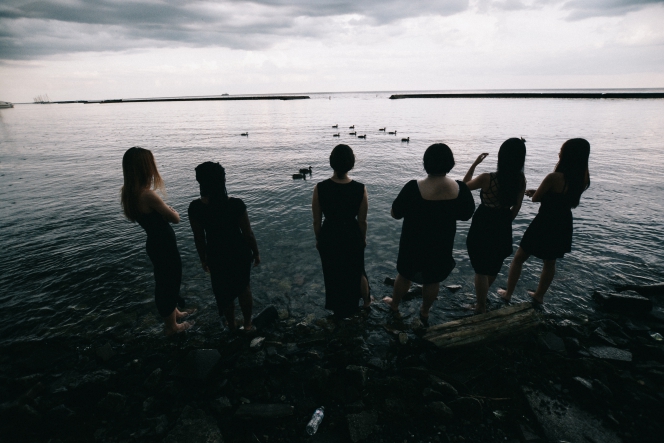“I like creating situations where I’m forced to do something and follow through,” says Aaron Jan. “It tricks my mind into finishing. I’m a rather lazy person, so part of my process in completing tasks is to place myself in a circumstance where I’m forced to do the work. Very millennial of me, I know.”
Along with Daniel Bagg, Zach Parkhurst and Andrew Markowiak, the ambitious young artist is co-founder of the Filament Incubator; a platform dedicated to supporting Toronto’s emerging theatre talent.
The program opened last spring with a bold plan to mount eight shows in eight months, with four projects of their own and four co-productions.
Most recently, they presented Curtis te Brinke’s Tire Swing, a small town queer coming-of-age story about three kids involved in the disappearance of one of their friends, years earlier.
This month, Jan turns his attention to his own show, Swan.
Based on an incident in his hometown of Hamilton where a group of teens beat a majestic white bird to death, the play follows a lesbian environmental club as they try to solve the shocking act of violence.

“It’s a queer, detective-horror play featuring six women of colour onstage as protagonists rather than side characters,” Jan says. “It’s a genre that’s rarely seen on stages, let alone with queer women of colour. The play also offers a unique perspective of growing up different in the suburbs and the consequences of hiding who you truly are.”
But despite the story’s queerness, Jan wasn’t interested in offering his audience a voyage of sexual self-discovery.
“It’s not a story about their coming out or coming of age,” he says. “These are six hungry, powerful queer women who know where they sit in their sexualities and are tasked with solving a series of gruesome murders in spite of their differences. Think Zodiac or Silence of the Lambs with a predominantly queer cast.”
There’s an interesting twist in Jan’s relationship to his characters. While the show itself is steeped in queerness, Jan himself identifies as straight.
The idea of a heterosexual male writer, taking on the voices of queer women could be seen as contentious, but for Jan, his desire to explore these characters was an essential part of his process of self-education.
“The show’s been a great learning process and it’s been refreshing to educate myself about the experiences that my LGBTQ peers had to deal with in high school,” he says. “A lot of the process has been recognizing my privilege, shutting up and listening to stories from the community to ensure that these characters earn their voices.”
“A common question that will come up is why these characters have to be queer women,” he adds. “My counter question would be why shouldn’t they be? Why is the standard norm for our heroes in theatre straight white men? I’m fortunate to have a group of queer artists working on this project that I was able to consult with during the early rehearsal process to ensure the voices and experiences of the characters were truthful.”

While not exclusively queer, the Filament Incubator is largely dedicated to supporting the work of queer and minority artists. The program’s diversity isn’t lip service to the growing push to dehomogenize the city’s theatre institutions. Instead, it’s a slick producing strategy.
Particularly for emerging theatre artists, generating an audience can initially be difficult because you can only churn out so many projects a year. By uniting eight projects under one banner, they immediately create a kind of theatre season, where audiences who come to one project might feel inspired to see something else on offer.
“One of the biggest problems with theatre-making grads is they compete against each other, whether it be in festivals or by programming work at the same time,” Jan says. “We lose the sense of camaraderie because we’re fighting for the same audiences. With this approach, we can grow an audience together.”
“If we don’t learn how to hustle, if we just sit and wait for opportunities to hit us, what’s the fucking point?” he adds. “If we’re not hungry as theatre makers and actively feeding that hunger, we’re not really doing our jobs.”
Like a lot of young DIY theatre organizations, much of the attention and support the company receives comes from its peers. By combining forces and producing an eight-show season, part of the audience they need is already made up by artists from the other companies.
The teaser for Aaron Jan’s play, Swan, which debuts in Toronto at Theatre Passe Muraille on Nov 2, 2016.
Little Black Afro Theatre Company/YouTube
Still, that’s not nearly enough bums in seats for a successful run, so they need more people to turn out. Younger queer people are, of course, a key demographic. But older queers, especially the kind who can easily afford the cost of a ticket, are critical to their success.
So does Jan feel like the company is getting the support it needs from the broader community?
“I’m not actually sure I can answer this question,” he says. “But one of the things I noted when the audition posting came up was how quickly it spread through the queer and brown theatre community from established and emerging artists alike.”
“The project’s been embraced and supported by queer and brown artistic directors and administrators because I think it fills a hole that’s never really been filled,” he continues. “I’m pretty jazzed about it to be honest.”
Swan
Nov 2–Nov 13, 2016
Theatre Passe Muraille, 16 Ryerson Ave, Toronto
Purchase tickets at artsboxoffice.ca, by phone at 416-504-7529, and in person at Theatre Passe Muraille.


 Why you can trust Xtra
Why you can trust Xtra


